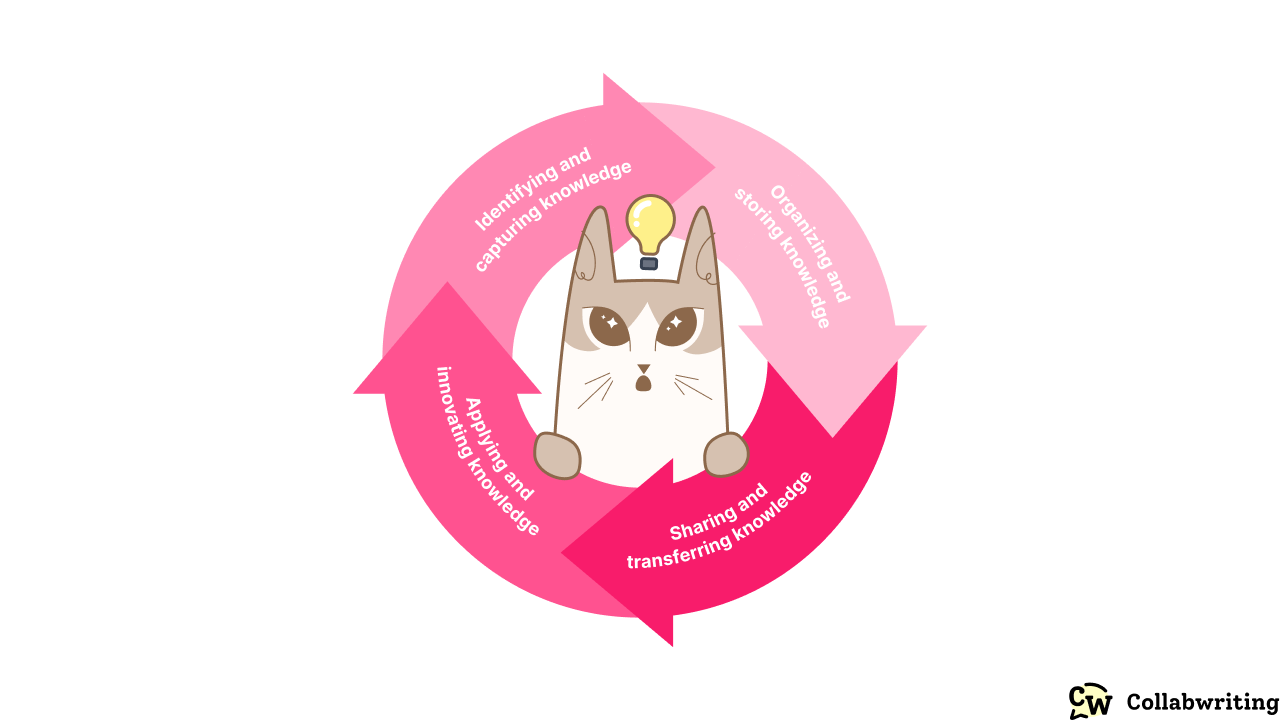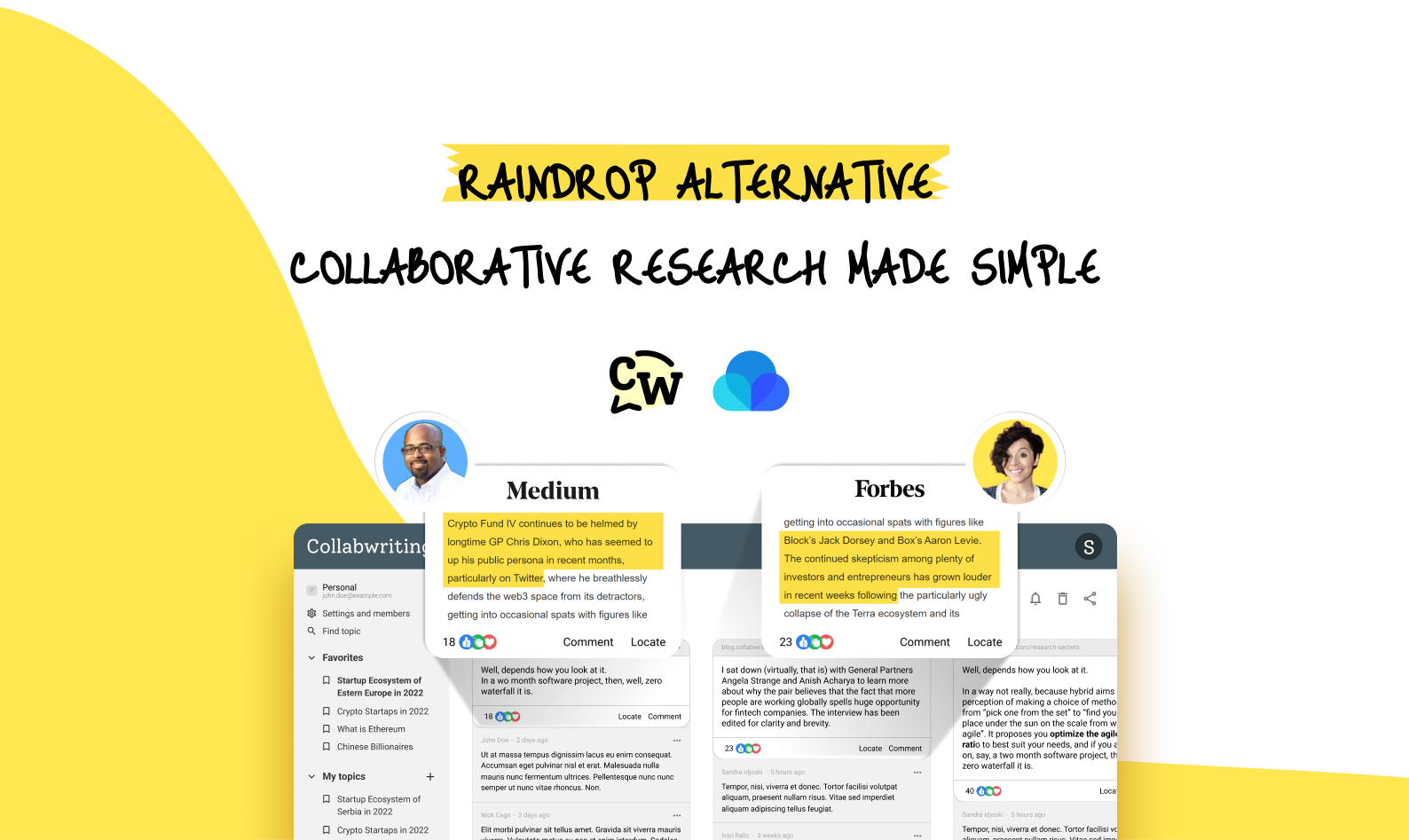Keeping all the important knowledge inside the company can be tricky. Sorting it out, figuring it out, and sharing it can be a puzzle because there's always a ton of new stuff pouring in every day.
To prevent teams and people in the company from getting confused, and to make the knowledge management process easier for them, there's something called the knowledge management cycle.
In this article, we’ll cover the knowledge management cycle, explain its four main steps, explore its benefits, and show how tools like Collabwriting simplify the process.
What is the Knowledge Management Cycle?
The knowledge management cycle is a systematic approach to capturing, organizing, sharing, and applying knowledge within an organization.
It ensures that information doesn’t get lost, employees can find what they need, and teams can make better decisions faster.
You might also hear it called the knowledge cycle - it’s essentially the same process of continuously managing knowledge so it fuels learning, innovation, and growth.
Types of Knowledge - 3 Main Types
Before diving into the steps, it’s helpful to understand the types of knowledge you’ll manage in the cycle:
- Explicit knowledge: This is information you can write down and share. It's the kind of knowledge that's easy for employees to access and pass along. For instance, it could be details about a product in a case study.
- Implicit knowledge: This is what you learn through experience. So, if explicit knowledge is the info in a case study, implicit knowledge is what you get when you actually use that info. Like applying it in a meeting with a client.
- Tacit knowledge: This is trickier to put into words and share formally. Think of it as the unspoken rules in a workplace, like how employees are expected to interact with clients, such as dressing a certain way.
Knowledge Management Cycle - The 4 Steps
The process of creating a culture that values knowledge sharing can be pretty simple if you follow the 4 main steps.
Step 1: Identifying and capturing knowledge
The first step in the knowledge management cycle involves collecting insights and expertise from various sources.
Techniques include:
- Knowledge mapping - Visualize what your organization knows and spot gaps. Think of it as creating a map of all types of knowledge: written materials like documents and reports, as well as hands-on expertise. This helps focus on capturing the most important knowledge.
- Expert interviews - Talk to people with specialized experience. Whether one-on-one, in groups, or virtually, these conversations reveal valuable insights that aren’t documented anywhere else.
- Document analysis - Review reports, manuals, research papers, and other existing materials. Systematic analysis uncovers hidden insights and best practices.
Once this knowledge is gathered, it needs to be stored in an organized way in knowledge repositories, such as databases or wikis. These repositories act as central hubs where everyone in the organization can easily find and share knowledge.
Modern knowledge repositories can handle multiple formats: documents, videos, presentations, even audio recordings, and often include search tools and collaboration features, making it simple for everyone to access and contribute to the organization’s knowledge.

Collabwriting - Shareable Notes on Web Pages and PDFs
Collabwriting allows you to gather all your online sources in one place. No more endless scrolling, no more lost insights, just simple, structured knowledge at your fingertips.
Just highlight, save, and collaborate with anyone on any content you find online.
Step 2: Organizing and storing knowledge
Organizing knowledge is key for easy retrieval. During this step of the knowledge management cycle:
- Categorize knowledge into logical groups.
- Add tags and metadata to make it searchable.
- Set up a robust search system within your knowledge repository.
A well-structured system saves time, helps employees find information faster, and encourages collaboration.
Step 3: Sharing knowledge and transferring knowledge
The next step in the knowledge cycle is sharing knowledge across teams:
- Encourage open communication through team meetings, training sessions, and digital collaboration platforms.
- Use knowledge-sharing tools like Collabwriting to highlight, annotate, and share insights from documents, web pages, and PDFs.
- Foster a culture where employees feel motivated to contribute their knowledge.
When there's open communication and everyone works together, the organization taps into its collective smarts, leading to more cool ideas and better problem-solving.
Step 4: Applying and innovating with knowledge
The final step of the knowledge management cycle focuses on putting knowledge into action:
- Use collected insights to solve problems and make informed decisions.
- Apply learnings to improve processes and innovate new solutions.
- Continuously loop back by evaluating outcomes and feeding new knowledge into the cycle.
This ensures the organization remains agile, innovative, and competitive in its industry.
Keep the learning going. Make a loop where you learn from what you've done before. This way, the organization keeps getting better by staying updated and relevant.

Benefits Of Implementing a Knowledge Management Cycle
Putting a knowledge management cycle into action brings many good things to organizations.
- Improved decision-making – Access to accurate, organized knowledge reduces errors and guesswork.
- Increased efficiency - Teams spend less time searching for information and avoid redundant work.
- Fostered innovation - Easy access to knowledge sparks new ideas and problem-solving approaches.
- Enhanced organizational learning - A structured knowledge system promotes continuous improvement.
- Better team collaboration - Employees can share insights and work together seamlessly.
For example, using Collabwriting alongside the knowledge management cycle lets teams collect snippets from anywhere - web pages, PDFs, or videos - and turn them into a dynamic knowledge hub.
Learn more: 3 key benefits of sharing knowledge with team members (with examples)
Overcoming Challenges In The Knowledge Management Cycle
While the knowledge management cycle offers significant benefits, it also comes with its own set of challenges.
- Resistance to sharing knowledge - Some employees may be hesitant to share what they know. Overcoming this requires creating a culture that values collaboration and open communication. Encourage participation by offering incentives, recognizing contributions, and providing the support needed for employees to feel confident in sharing their expertise
- Maintaining up-to-date knowledge repositories - Knowledge can quickly become outdated if repositories aren’t regularly updated. Assign clear ownership of these repositories and set a schedule for reviewing and refreshing the content. This ensures information stays accurate, relevant, and useful for everyone in the organization.
- Choosing the right tools - Picking the right platforms is critical. The tools you select should align with your company’s goals, be easy to use, and support seamless knowledge capturing, organizing, and sharing. With the right technology in place, the knowledge management cycle becomes more efficient, helping employees access the information they need when they need it.

Best Practices for Successful Knowledge Management
Achieving successful knowledge management involves a few key steps.
1) Set clear goals and create a strategy in line with their business objectives. Knowing what matters helps you capture and organize information more effectively, ensuring your team focuses on insights that drive real results.
2) Build a culture of knowledge sharing - Encourage employees to contribute their expertise by recognizing their efforts, offering training, and creating a supportive environment. When everyone feels valued and empowered to share, knowledge flows more freely across the organization.
4) Leverage technology - Use tools like Collabwriting to streamline the process of capturing, organizing, and sharing knowledge. The right platform makes it easy for teams to collaborate, store insights, and access the information they need when they need it.
5) Regularly assess and improve - Track how knowledge is being used, employee engagement in sharing, and the overall impact on organizational performance. Continuously refine your knowledge management process to keep it relevant, effective, and aligned with evolving business goals.
Conclusion
The knowledge management cycle is a roadmap for turning raw information into actionable insights. By capturing, organizing, sharing, and applying knowledge, teams can work more efficiently, innovate faster, and build a culture of continuous learning.
With the right approach and tools, organizations can overcome knowledge management challenges, make smarter decisions, and stay resilient in a constantly changing business environment.
Start your journey by exploring Collabwriting and turn your organization’s knowledge into its greatest asset.

Collabwriting - Shareable Notes on Web Pages and PDFs
Collabwriting allows you to gather all your online sources in one place. No more endless scrolling, no more lost insights, just simple, structured knowledge at your fingertips.
Just highlight, save, and collaborate with anyone on any content you find online.
FAQ
What is the knowledge management cycle?
A systematic approach to capturing, organizing, sharing, and applying knowledge within an organization, usually in four steps: identify, organize, share, and apply.
Why is the knowledge management cycle important?
The knowledge management cycle is important because it helps organizations manage their knowledge effectively, reducing confusion and improving efficiency. It ensures that valuable information is captured, organized, and easily accessible, leading to better decision-making, innovation, and continuous improvement.
What are the three types of knowledge?
- Explicit Knowledge: Information that can be easily written down and shared, such as details in a case study.
- Implicit Knowledge: Skills and understanding gained through experience, like applying information from a case study in a real-world situation.
- Tacit Knowledge: Knowledge that is difficult to articulate and share formally, such as unspoken workplace norms and expectations.
How can an organization capture knowledge?
Organizations can capture knowledge through methods like knowledge mapping to visualize existing knowledge, expert interviews to gather insights, and document analysis to extract information from existing materials. This knowledge is then documented and stored in organized knowledge repositories.
What are the benefits of implementing a knowledge management cycle?
Benefits include improved decision-making, increased efficiency by reducing repetitive work, fostering a culture of continuous learning and innovation, and enhancing organizational creativity and adaptability. It also helps in creating a cohesive team environment where knowledge is easily accessible and shared.
What are some best practices for successful knowledge management?
Best practices include setting clear goals and aligning the knowledge management strategy with business objectives, building a culture that encourages knowledge sharing through incentives and recognition, providing training and support for effective knowledge management, and regularly assessing and improving knowledge management processes.
How can technology help in the knowledge management cycle?
Technology can help by providing tools for creating, organizing, and accessing knowledge repositories, facilitating communication and collaboration among employees, and offering platforms that support real-time information sharing and problem-solving.
What tool can help in documenting and sharing knowledge within the team?
Tools like Collabwriting can assist in capturing and sharing knowledge within the team, making the process more efficient and ensuring that important information is easily accessible to everyone.






![5 Tools Marketers Use to Organize Research - Compared [2025]](/content/images/2025/11/cover-4-1.png)

![Build Credibility in Research: Smart Way to Verify Information and Track Sources Easily [2025]](/content/images/2025/10/covers-for-blog--7--1.png)

![How Marketers Can Turn LinkedIn Content into Collaborative Research [2025]](/content/images/2025/10/covers-for-blog--8-.png)
![Best Readwise Alternative for Personal & Team Research [2025]](/content/images/2025/09/Frame-814--3-.png)


